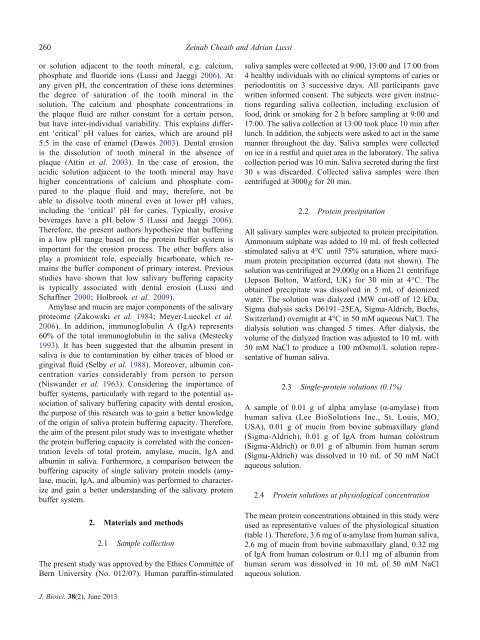Role of amylase, mucin, IgA and albumin on salivary protein ...
Role of amylase, mucin, IgA and albumin on salivary protein ...
Role of amylase, mucin, IgA and albumin on salivary protein ...
You also want an ePaper? Increase the reach of your titles
YUMPU automatically turns print PDFs into web optimized ePapers that Google loves.
260 Zeinab Cheaib <str<strong>on</strong>g>and</str<strong>on</strong>g> Adrian Lussi<br />
or soluti<strong>on</strong> adjacent to the tooth mineral, e.g. calcium,<br />
phosphate <str<strong>on</strong>g>and</str<strong>on</strong>g> fluoride i<strong>on</strong>s (Lussi <str<strong>on</strong>g>and</str<strong>on</strong>g> Jaeggi 2006). At<br />
any given pH, the c<strong>on</strong>centrati<strong>on</strong> <str<strong>on</strong>g>of</str<strong>on</strong>g> these i<strong>on</strong>s determines<br />
the degree <str<strong>on</strong>g>of</str<strong>on</strong>g> saturati<strong>on</strong> <str<strong>on</strong>g>of</str<strong>on</strong>g> the tooth mineral in the<br />
soluti<strong>on</strong>. The calcium <str<strong>on</strong>g>and</str<strong>on</strong>g> phosphate c<strong>on</strong>centrati<strong>on</strong>s in<br />
the plaque fluid are rather c<strong>on</strong>stant for a certain pers<strong>on</strong>,<br />
but have inter-individual variability. This explains different<br />
‘critical’ pH values for caries, which are around pH<br />
5.5 in the case <str<strong>on</strong>g>of</str<strong>on</strong>g> enamel (Dawes 2003). Dental erosi<strong>on</strong><br />
is the dissoluti<strong>on</strong> <str<strong>on</strong>g>of</str<strong>on</strong>g> tooth mineral in the absence <str<strong>on</strong>g>of</str<strong>on</strong>g><br />
plaque (Attin et al. 2003). In the case <str<strong>on</strong>g>of</str<strong>on</strong>g> erosi<strong>on</strong>, the<br />
acidic soluti<strong>on</strong> adjacent to the tooth mineral may have<br />
higher c<strong>on</strong>centrati<strong>on</strong>s <str<strong>on</strong>g>of</str<strong>on</strong>g> calcium <str<strong>on</strong>g>and</str<strong>on</strong>g> phosphate compared<br />
to the plaque fluid <str<strong>on</strong>g>and</str<strong>on</strong>g> may, therefore, not be<br />
able to dissolve tooth mineral even at lower pH values,<br />
including the ‘critical’ pH for caries. Typically, erosive<br />
beverages have a pH below 5 (Lussi <str<strong>on</strong>g>and</str<strong>on</strong>g> Jaeggi 2006).<br />
Therefore, the present authors hypothesize that buffering<br />
in a low pH range based <strong>on</strong> the <strong>protein</strong> buffer system is<br />
important for the erosi<strong>on</strong> process. The other buffers also<br />
play a prominent role, especially bicarb<strong>on</strong>ate, which remains<br />
the buffer comp<strong>on</strong>ent <str<strong>on</strong>g>of</str<strong>on</strong>g> primary interest. Previous<br />
studies have shown that low <strong>salivary</strong> buffering capacity<br />
is typically associated with dental erosi<strong>on</strong> (Lussi <str<strong>on</strong>g>and</str<strong>on</strong>g><br />
Schaffner 2000; Holbrook et al. 2009).<br />
Amylase <str<strong>on</strong>g>and</str<strong>on</strong>g> <str<strong>on</strong>g>mucin</str<strong>on</strong>g> are major comp<strong>on</strong>ents <str<strong>on</strong>g>of</str<strong>on</strong>g> the <strong>salivary</strong><br />
proteome (Zakowski et al. 1984; Meyer-Lueckel et al.<br />
2006). In additi<strong>on</strong>, immunoglobulin A (<str<strong>on</strong>g>IgA</str<strong>on</strong>g>) represents<br />
60% <str<strong>on</strong>g>of</str<strong>on</strong>g> the total immunoglobulin in the saliva (Mestecky<br />
1993). It has been suggested that the <str<strong>on</strong>g>albumin</str<strong>on</strong>g> present in<br />
saliva is due to c<strong>on</strong>taminati<strong>on</strong> by either traces <str<strong>on</strong>g>of</str<strong>on</strong>g> blood or<br />
gingival fluid (Selby et al. 1988). Moreover, <str<strong>on</strong>g>albumin</str<strong>on</strong>g> c<strong>on</strong>centrati<strong>on</strong><br />
varies c<strong>on</strong>siderably from pers<strong>on</strong> to pers<strong>on</strong><br />
(Nisw<str<strong>on</strong>g>and</str<strong>on</strong>g>er et al. 1963). C<strong>on</strong>sidering the importance <str<strong>on</strong>g>of</str<strong>on</strong>g><br />
buffer systems, particularly with regard to the potential associati<strong>on</strong><br />
<str<strong>on</strong>g>of</str<strong>on</strong>g> <strong>salivary</strong> buffering capacity with dental erosi<strong>on</strong>,<br />
the purpose <str<strong>on</strong>g>of</str<strong>on</strong>g> this research was to gain a better knowledge<br />
<str<strong>on</strong>g>of</str<strong>on</strong>g> the origin <str<strong>on</strong>g>of</str<strong>on</strong>g> saliva <strong>protein</strong> buffering capacity. Therefore,<br />
the aim <str<strong>on</strong>g>of</str<strong>on</strong>g> the present pilot study was to investigate whether<br />
the <strong>protein</strong> buffering capacity is correlated with the c<strong>on</strong>centrati<strong>on</strong><br />
levels <str<strong>on</strong>g>of</str<strong>on</strong>g> total <strong>protein</strong>, <str<strong>on</strong>g>amylase</str<strong>on</strong>g>, <str<strong>on</strong>g>mucin</str<strong>on</strong>g>, <str<strong>on</strong>g>IgA</str<strong>on</strong>g> <str<strong>on</strong>g>and</str<strong>on</strong>g><br />
<str<strong>on</strong>g>albumin</str<strong>on</strong>g> in saliva. Furthermore, a comparis<strong>on</strong> between the<br />
buffering capacity <str<strong>on</strong>g>of</str<strong>on</strong>g> single <strong>salivary</strong> <strong>protein</strong> models (<str<strong>on</strong>g>amylase</str<strong>on</strong>g>,<br />
<str<strong>on</strong>g>mucin</str<strong>on</strong>g>, <str<strong>on</strong>g>IgA</str<strong>on</strong>g>, <str<strong>on</strong>g>and</str<strong>on</strong>g> <str<strong>on</strong>g>albumin</str<strong>on</strong>g>) was performed to characterize<br />
<str<strong>on</strong>g>and</str<strong>on</strong>g> gain a better underst<str<strong>on</strong>g>and</str<strong>on</strong>g>ing <str<strong>on</strong>g>of</str<strong>on</strong>g> the <strong>salivary</strong> <strong>protein</strong><br />
buffer system.<br />
2. Materials <str<strong>on</strong>g>and</str<strong>on</strong>g> methods<br />
2.1 Sample collecti<strong>on</strong><br />
The present study was approved by the Ethics Committee <str<strong>on</strong>g>of</str<strong>on</strong>g><br />
Bern University (No. 012/07). Human paraffin-stimulated<br />
saliva samples were collected at 9:00, 13:00 <str<strong>on</strong>g>and</str<strong>on</strong>g> 17:00 from<br />
4 healthy individuals with no clinical symptoms <str<strong>on</strong>g>of</str<strong>on</strong>g> caries or<br />
period<strong>on</strong>titis <strong>on</strong> 3 successive days. All participants gave<br />
written informed c<strong>on</strong>sent. The subjects were given instructi<strong>on</strong>s<br />
regarding saliva collecti<strong>on</strong>, including exclusi<strong>on</strong> <str<strong>on</strong>g>of</str<strong>on</strong>g><br />
food, drink or smoking for 2 h before sampling at 9:00 <str<strong>on</strong>g>and</str<strong>on</strong>g><br />
17:00. The saliva collecti<strong>on</strong> at 13:00 took place 10 min after<br />
lunch. In additi<strong>on</strong>, the subjects were asked to act in the same<br />
manner throughout the day. Saliva samples were collected<br />
<strong>on</strong> ice in a restful <str<strong>on</strong>g>and</str<strong>on</strong>g> quiet area in the laboratory. The saliva<br />
collecti<strong>on</strong> period was 10 min. Saliva secreted during the first<br />
30 s was discarded. Collected saliva samples were then<br />
centrifuged at 3000g for 20 min.<br />
2.2 Protein precipitati<strong>on</strong><br />
All <strong>salivary</strong> samples were subjected to <strong>protein</strong> precipitati<strong>on</strong>.<br />
Amm<strong>on</strong>ium sulphate was added to 10 mL <str<strong>on</strong>g>of</str<strong>on</strong>g> fresh collected<br />
stimulated saliva at 4°C until 75% saturati<strong>on</strong>, where maximum<br />
<strong>protein</strong> precipitati<strong>on</strong> occurred (data not shown). The<br />
soluti<strong>on</strong> was centrifuged at 29,000g <strong>on</strong> a Hicen 21 centrifuge<br />
(Jeps<strong>on</strong> Bolt<strong>on</strong>, Watford, UK) for 30 min at 4°C. The<br />
obtained precipitate was dissolved in 5 mL <str<strong>on</strong>g>of</str<strong>on</strong>g> dei<strong>on</strong>ized<br />
water. The soluti<strong>on</strong> was dialyzed (MW cut-<str<strong>on</strong>g>of</str<strong>on</strong>g>f <str<strong>on</strong>g>of</str<strong>on</strong>g> 12 kDa,<br />
Sigma dialysis sacks D6191–25EA, Sigma-Aldrich, Buchs,<br />
Switzerl<str<strong>on</strong>g>and</str<strong>on</strong>g>) overnight at 4°C in 50 mM aqueous NaCl. The<br />
dialysis soluti<strong>on</strong> was changed 5 times. After dialysis, the<br />
volume <str<strong>on</strong>g>of</str<strong>on</strong>g> the dialyzed fracti<strong>on</strong> was adjusted to 10 mL with<br />
50 mM NaCl to produce a 100 mOsmol/L soluti<strong>on</strong> representative<br />
<str<strong>on</strong>g>of</str<strong>on</strong>g> human saliva.<br />
2.3 Single-<strong>protein</strong> soluti<strong>on</strong>s (0.1%)<br />
A sample <str<strong>on</strong>g>of</str<strong>on</strong>g> 0.01 g <str<strong>on</strong>g>of</str<strong>on</strong>g> alpha <str<strong>on</strong>g>amylase</str<strong>on</strong>g> (α-<str<strong>on</strong>g>amylase</str<strong>on</strong>g>) from<br />
human saliva (Lee BioSoluti<strong>on</strong>s Inc., St. Louis, MO,<br />
USA), 0.01 g <str<strong>on</strong>g>of</str<strong>on</strong>g> <str<strong>on</strong>g>mucin</str<strong>on</strong>g> from bovine submaxillary gl<str<strong>on</strong>g>and</str<strong>on</strong>g><br />
(Sigma-Aldrich), 0.01 g <str<strong>on</strong>g>of</str<strong>on</strong>g> <str<strong>on</strong>g>IgA</str<strong>on</strong>g> from human colostrum<br />
(Sigma-Aldrich) or 0.01 g <str<strong>on</strong>g>of</str<strong>on</strong>g> <str<strong>on</strong>g>albumin</str<strong>on</strong>g> from human serum<br />
(Sigma-Aldrich) was dissolved in 10 mL <str<strong>on</strong>g>of</str<strong>on</strong>g> 50 mM NaCl<br />
aqueous soluti<strong>on</strong>.<br />
2.4 Protein soluti<strong>on</strong>s at physiological c<strong>on</strong>centrati<strong>on</strong><br />
The mean <strong>protein</strong> c<strong>on</strong>centrati<strong>on</strong>s obtained in this study were<br />
used as representative values <str<strong>on</strong>g>of</str<strong>on</strong>g> the physiological situati<strong>on</strong><br />
(table 1). Therefore, 3.6 mg <str<strong>on</strong>g>of</str<strong>on</strong>g> α-<str<strong>on</strong>g>amylase</str<strong>on</strong>g> from human saliva,<br />
2.6 mg <str<strong>on</strong>g>of</str<strong>on</strong>g> <str<strong>on</strong>g>mucin</str<strong>on</strong>g> from bovine submaxillary gl<str<strong>on</strong>g>and</str<strong>on</strong>g>, 0.32 mg<br />
<str<strong>on</strong>g>of</str<strong>on</strong>g> <str<strong>on</strong>g>IgA</str<strong>on</strong>g> from human colostrum or 0.11 mg <str<strong>on</strong>g>of</str<strong>on</strong>g> <str<strong>on</strong>g>albumin</str<strong>on</strong>g> from<br />
humanserumwasdissolvedin10mL<str<strong>on</strong>g>of</str<strong>on</strong>g>50mMNaCl<br />
aqueous soluti<strong>on</strong>.<br />
J. Biosci. 38(2), June 2013
















